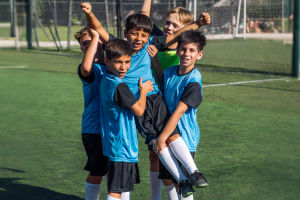
Participating in sports can be a transformative experience for children, providing them with opportunities to develop essential skills, forge new friendships, and maintain an active lifestyle.
However, many youth from low-income families, immigrant communities, or those living in unsafe neighborhoods face significant hurdles that restrict their participation in sports.
These challenges not only limit the social and psychological benefits associated with sports but also hinder the development of their athletic potential.
Understanding the Challenges
A troubling finding from Statistics Canada highlights that many minority children do not see participating in sports as a priority, often focusing more on academic achievements. Parents who work long hours, especially those from low-income backgrounds, may push their children toward educational success, viewing it as the essential path to a brighter future. Consequently, sports may become sidelined in favor of schoolwork.
For new immigrant families, cultural perceptions about sports can pose additional challenges. Many individuals come from backgrounds where athletics are not emphasized, leading parents to overlook the myriad benefits of physical activity. Furthermore, cultural expectations and commitments may prioritize education and family obligations over sports participation, especially for girls who might feel less encouraged to engage in physical activities.
Access to Opportunities
A significant barrier to participation stems from the structured nature of sports systems in Canada. Many newcomers are accustomed to informal, spontaneous games rather than rigid leagues. This transition can feel intimidating and unwelcoming, preventing them from engaging in community sports fully. Furthermore, language barriers and lack of information regarding available resources make it more challenging for families who do not speak English or French fluently.
The presence of role models within sports is another crucial factor. Children from minority backgrounds may struggle to identify with the athletes they see in the media or programs led by those outside their communities. The resulting sense of isolation can discourage them from participating, perpetuating a cycle of exclusion.
Financial Barriers
Perhaps the most significant obstacle in the way of youth sports participation is financial. Many families, particularly those with low incomes, cannot afford the costs associated with organized sports, including registration fees, equipment, and travel expenses. For young athletes aspiring to join competitive teams, these financial burdens can prove insurmountable, ultimately stifling their growth and diminishing their chances to excel in their chosen sports.
Additionally, when parents work multiple jobs to make ends meet, children are often saddled with extra responsibilities, leaving little time or energy for sports. This dynamic can rob talented youth of essential opportunities that are more readily available to their higher-income counterparts.
Solutions and Support
Organizations like the Boys and Girls Club of Canada evolve solutions by providing accessible sports programming and supportive environments. By offering coaching, mentorship, and necessary resources, these organizations address the challenges faced by underserved youth, allowing for safer and more equitable sports participation.
Programs such as KidSport offer valuable financial assistance for registration fees and equipment, helping to level the playing field for youth athletes in need. Cities like Langford, BC, have developed initiatives to fund sports for those who would otherwise struggle to join organized activities.
By fostering partnerships with community organizations and ethnic groups, it is possible to create a more inclusive sports environment that respects cultural differences while promoting participation. Tailoring programs to meet the scheduling needs of youth and accommodating their commitments can significantly improve engagement.
Conclusion
In summary, tackling the barriers that hinder youth from participating in sports is vital for nurturing talent and building community spirit. Programs that recognize and address the particular challenges faced by underserved communities can pave the way for greater inclusivity and sports development.
With concerted efforts at both local and national levels, the landscape of youth sports can transform, ensuring all children have the opportunity to thrive and participate in the recreation they deserve.


